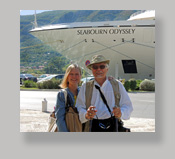 
VENICE | CROATIA | MONTENEGRO | CORFU | KAFALONIA | PYLOS | NAFPLION | PIRAEUS | MILOS | MYKONOS PATMOS | KUSADASI | CHIOS | ISTANBUL DAY 1 | ISTANBUL DAY 2 | ISTANBUL DAY 3 | TRAVEL REFLECTIONS |
 
VENICE | CROATIA | MONTENEGRO | CORFU | KAFALONIA | PYLOS | NAFPLION | PIRAEUS | MILOS | MYKONOS PATMOS | KUSADASI | CHIOS | ISTANBUL DAY 1 | ISTANBUL DAY 2 | ISTANBUL DAY 3 | TRAVEL REFLECTIONS |
KUSADASI, gateway to ANCIENT EPHESUS 10-3-12
This was our busiest day so far. We hired a private car and guide to take us around. The guide, Bilant, was great. His whole family on both sides were or are going to be doctors. He was a medical archeologist before he injured his back and had worked in the Ephesus site. He teaches at one of the universities, is widely traveled - in short, a great draw. He was the guide for the Clintons, the Bushes, and Bill Gates when they visited the country. Very knowledgeable and a nice man. And he's probably going to be around for a long time. Three of his grandparents are over 100, including a grandmother who's 106. Outside of Kusadasi, a port city that is big and bustling, the countryside is rustic. The seaside areas are lined with 5 star hotels and summer homes for both Turkish citizens and expats. He is a good salesman for Turkey and brags constantly about the country being first or almost so in one area of another. He made the day fly by.
This "main street" runs through the city and passes by temples, large open markets, homes, the huge library of Celsus, a senate area, bath houses, an amphitheater (which brought famous singers and orchestras from all over the world over the last 30 or 40 years), gladiator rings, a hospital, and on and on. We walked for miles and, the guide said, that we have only seen 10% of the City. The rest remains to be excavated over the next decades. The Turkish Government is doing quite well financially and spent 6 billion dollars last year on archeological excavations around the country, not just Ephesus. Ephesus made some medical history as well. An ancient physician somehow figured out that if he combined two poisonous substances, snake The guide told us some interesting political history about ancient Ephesus. There was an upper and lower house of government. Before going into session, they had to listen to music on the theory that it made for better deliberations. The lower house of government had 450 representatives. The upper house had 50 senators, 26 of whom were elected by the all-powerful priestesses at the Temple of Artemis. Naturally, their 26 choices were all women. Since the senate was more powerful than the lower assembly, this meant that women controlled the political decision making in town. Bilant said that even today, Turkey is matriarchal. He pointed out that Turkey has had eleven women generals in recent times, but the U.S. only one. The Turks interestingly make much of the fact that both St. John and St. Paul preached in the city. St. Paul, after speaking to the Ephesians in the Great Amphitheatre (where CC walked the stairs in the section that was open to visitors and also went down to the amphitheater After this we went to a site which was said to be the final home of the Virgin Mary on Mt. Pagus who came to Ephesus with John. Mary, St. John, and St. Luke are all supposed to have died in Ephesus. We then went to the nearby town of Seljuk where we visited the ruins of St. John's Basilica (another victim of the earthquakes). It was We came back to the ship along the very well developed seashore looking at beaches and the five star hotels. The west coast of Turkey is beautiful and there seem to be no end of new vacation homes and new hotels being built. Kusadasi is part of what Bilant described as a two hundred mile long beach. |